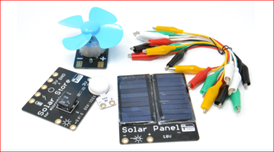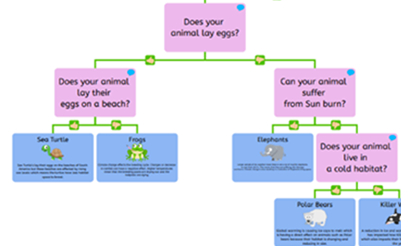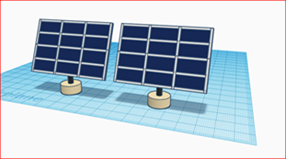21 February 2022
Changing the Climate: Bringing Environmental Issues to Life
It is so important that as teachers of computing we play our part in the urgent global issue of climate change. We are well-equipped for the challenge: we have access to the data, presentation tools, physical devices and creative platforms which can really inspire students. Time is always an issue in schools, so it is important we link up to other subject areas and encourage families to become involved at home.
This article provides ideas for both primary and secondary and is supported by CAS Inspire videos, presentations, lesson ideas and further reading. We are focusing on five areas:
- Where to find effective resources that you can use in school
- Where to access affordable equipment
- Events you could host in your class/school linked to climate change
- Example lesson ideas
- Practicalities of inclusion into the existing curriculum.
Resources
Providing three-dimensional views is a really engaging way to start a topic linked to climate change. Being able to rotate a globe to show ice caps or desert areas encourages discussion and allows questions such as ‘are the ice caps reducing in size?’ to be asked. Schools can access Google Earth via a webpage or an App. This also allows users to search for places in the world using terms such as ‘wind farm’. This search also provides guided tours which direct you around different locations providing useful facts.
An effective alternative which allows a paper-based world map to be scanned and transformed into a 3D globe is the free app Quivervision The software turns a 2D image into 3D allowing the topic of augmented reality to be experienced. A 2-dimensional sheet of paper is coloured in. When this picture is scanned by the device the picture is augmented, or added to, by becoming a https://quivervision.com/coloring-packs/Earth-Day that can be manipulated. For example, it can be rotated by moving a finger on the screen of the device. Quivervision also offers FREE lesson ideas.
It is useful to view and discuss the 17 sustainable development goals created by The United Nations that link up with climate change. This is an ideal research activity with students choosing one of the relevant goals and then using their creativity to present that to others. Tools include:
- Presentation tools. (e.g., PowerPoint, Keynote, Google Slides or Adobe Spark)
- Video creation (e.g., Moviemaker, iMovie, Clips)
- Greenscreen Film making (e.g. Doink App, Powerpoint, iMovie + PowerPoint). This process is formally known as chromakey.
- Podcasting (e.g., Audacity or Soundrecorder App with MP3 uploaded to a site that can be subscribed to, so the user gets an update of when the next podcast is created)
- Desktop Publishing (e.g., Canva for education).
To create meaningful information, we need to put data together. This idea provides a useful springboard for talking about misinformation. For example, if we are talking about the temperature of the sea or the air we need to think about trends over time and the source of the data. Well-respected websites such as NASA provide activities, ideas and the data needed for use in the classroom. In terms of trends, the UK Government has created a useful overview with charts that can be interpreted and analysed (pages 13 and 14 focus on renewable energy).
Affordable equipment
I have found the solar education kit 723 to be invaluable. The impact is immediate when the miniature solar panel is connected to a speaker that changes the pitch of a sound based on the amount of light shining on it. Wires can be simply moved around to change voltages between 1.5V and 4.5V and outputs from 100mA up to 300mA. A well-written booklet explains how to connect a low-inertia DC motor and lamp.
In commercial situations energy created must be stored. The energy output created by wind, hydro and solar varies based on weather conditions. Therefore, after it is ‘harvested’ it must be stored for later use. The solar energy project kit for micro:bit helps students understand this using a practical and experiment-led approach. The kit has 6 projects including one based on micropython.
A micro:bit can be programmed and supplied with energy from the solar store. A set of these credit card sized computers can be borrowed from NCCE hubs. They can also be purchased via a range of suppliers.
Note 1: Vs2 is the latest micro:bit with microphone, sounder and conductive logo.
Note 2: a range of other physical kit can be borrowed from NCCE hubs. Training is supplied and required before the kits are lent to your school.
Events
Activities are enhanced when there is an event at the end of a project or series of lessons. Here are 6 ideas.
- Climate change showcase for other classes, parents, or the community. Barefoot provides some useful ideas and resources for Primary Schools
- Energy event for families (including a presentation, information, and equipment)
- Videos linked to the project. These could include tutorials on the software used that are then published on the school website or social media feed
- Online discussion with your local authority about climate actions taken. (The Guardian reported that 20% of councils have no climate action plan). This can link with discussion in which the policies of political parties are discussed.
- Invite local radio to discuss climate change with an outside broadcast from your school
- Produce a podcast that can be shared and subscribed to.
Climate change lessons in Primary and Secondary
Primary: designed by Rebecca Hindle (Apley Wood Primary School):

The lesson focuses on the use of a branching database from J2e that allows the students to sort animals into groups based on the effect of climate change. A branching database requires yes/no answers. The lessons are based on a Year 3 NCCE unit which has been adapted by Rebecca.
Key areas considered:
- How do you anchor the learning to make it memorable and meaningful?
- What prior knowledge do the children have that can be drawn on?
- What knowledge do they need to be taught specifically for this task?
A sequence of lessons was created based on the Year 3 NCCE unit. Rebecca added in an extra lesson for research purposes. This provided more cross-curricular opportunities such as the creation of a non-chronological report in English. Research could be carried out online (independent or teacher led) using safer search engines such as Kiddle or Swiggle. Rebecca said, “I had to ensure work was differentiated and suitable to the needs of my class.” (See A, B and C below)
- A. Notes made from the video and completed their own table of findings.
- B. Watched video and were provided with key sentences to match and copy into relevant sections.
- C. Were provided with pictures and cut out sentences so they could stick them into the relevant sections.
Rebecca added "using the branching database the class worked through a series of yes/no questions and we chose those that could be appropriate. Some children had a group of questions to choose from to support their learning. We differentiated by how many animals were included in the branching database. The minimum is 2."
"The topic was of great interest to the children, and they were highly engaged. In terms of what I would do differently next time. I would develop their knowledge over a longer period which would allow the children to be more independent."
Secondary: Natalie Stewart from Hadley Learning Community and CAS Leader for Telford Mixed Hub
 The content centres around do your :bit which brings together the micro:bit and the UN’s Global Goals to provide inspiring activities for your classroom or club and an exciting digital challenge. The project involves having fun with the micro:bit and developing world- changing ideas and solutions using technology. Students are encouraged to apply their digital skills to real world situations.
The content centres around do your :bit which brings together the micro:bit and the UN’s Global Goals to provide inspiring activities for your classroom or club and an exciting digital challenge. The project involves having fun with the micro:bit and developing world- changing ideas and solutions using technology. Students are encouraged to apply their digital skills to real world situations.
Natalie said, “In 2019 Hadley Learning Community won an Industrial Cadets Award for their ‘Seek A Shelter’ temporary cover for homeless people. I really like the way the ‘do your bit’ content requires the use of technology to solve real world problems. I plan to use some of the 9 lessons and inspiring videos within our curriculum. We are hoping to enter the challenge which is open from now until 15 July 2022. I like the way there are three distinct categories for different age groups.”
She added “as a CAS Community leader I find the regular newsletter and blog posts useful. For example, Bill Harvey has written an inspiring blog post about how a group of children explored 'Healthy Oceans'. There is over 80 pieces of news and blog posts that can be searched.”
Practicalities of inclusion climate change content into the existing curriculum
Both the primary curriculum and the secondary curriculum are really packed with content, and recently I have noticed even more pressures on teachers due to the demands for ‘catchup’ linked to COVID restrictions. The practicalities of including climate change-based content requires discussion with other subject leads so that there is coordination and progression of digital skills.
The National Centre for Computing (NCCE) has helped by producing a Computing curriculum that is flexible. Rebecca Hindle refers to adapting a Year 3 unit for her school and linking it with the English Curriculum. A good starting point for staff is to download the ‘Curriculum Journey’ for students from Year 1 to Year 11. Once this useful progression document has been looked at in detail, information for each key stage can be viewed here. (You will need to create a FREE account to access all the documents).
This can be used to help teachers build their own curriculum that is tailored to the needs of the community and that takes advantage of specific software and hardware that is available.
 For example, it may be appropriate for students to design solar panels using the FREE Tinkercad software to enhance their understanding of renewable energy. This could link with content within the Design and Technology curriculum and encourage discussion within PSHE lessons around methods of slowing down climate change. The opportunity should be provided for discussion around the pros and cons of land and sea use for renewable energy supply. For example, some people consider that the increase of solar farms may reduce the biodiversity of plants and animals within the area.
For example, it may be appropriate for students to design solar panels using the FREE Tinkercad software to enhance their understanding of renewable energy. This could link with content within the Design and Technology curriculum and encourage discussion within PSHE lessons around methods of slowing down climate change. The opportunity should be provided for discussion around the pros and cons of land and sea use for renewable energy supply. For example, some people consider that the increase of solar farms may reduce the biodiversity of plants and animals within the area.
Teaching about climate change is so important that I believe we need to find creative ways of providing opportunities for students to become involved.
Further reading and resources
Education Secretary puts climate change at the heart of education
Teachers and pupils frustrated over climate education
Innovate for Climate Change: Apps for Good
Together for our planet resources
Lesson plan and Videos
Exploring solar panels with Tinkercad
Richard Smith is a CAS Community Leader for Telford, Mixed CAS Community and Founder of AmazingICT.

